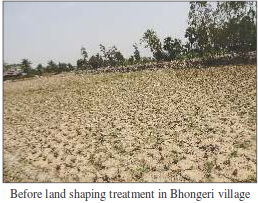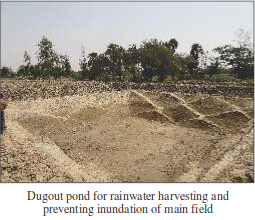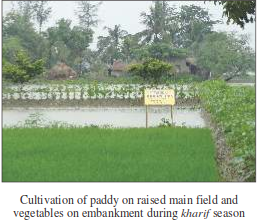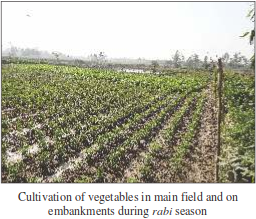Rejuvenation of farming in cyclone and flood prone coastal agro-ecosystems through land shaping
Rejuvenation of farming in cyclone and flood prone coastal agro-ecosystems through land shaping
Climate vulnerability : Floods, Cyclone
The coastal region of West Bengal is ecologically vulnerable to the vagaries of climate variability such as cyclones and floods. These extreme events play havoc with agriculture and livelihoods of farmers. One such event in the recent past was the occurrence of the super cyclone 'Aila' on 25 May, 2009. The village Bhongeri of South 24 Parganas district situated close to the brackish water river Matla experienced extreme cyclonic weather and ingression of saline water into cultivable areas rendering the fields saline and unfit for farming. Reclamation of saline affected fields is a slow process and the problem of salinity continued to persist even after 2-3 monsoon seasons.
Existing practice
Farmers in this village predominantly practice paddy-fallow cropping system. The low lying village suffers from inundation of paddy fields up to 3-4' of rainwater which is a recurrent problem during the monsoon season due to high rainfall (1600 to 1800 mm) and use low yielding deep water paddy varieties. During the rabi-summer season, scarcity of water for irrigation and soil salinity are the main problems limiting the possibility of a second crop.
Resilient practice / technology
Land shaping for rainwater harvesting, utilization & integration of farm enterprises
In order to overcome submergence during kharif, salinity problem in rabi and augment availability of irrigation water during the rabi-summer season, an engineering solution was promoted by the KVK, Nimpith. About 20% area in selected lowland fields was excavated up to 8-9 feet depth. This dugout pond was used for harvesting rainwater. The excavated soil was spread over the adjacent field area (80%) so as to raise the field level up to 1 to 1.5 feet and also to raise the field border embankments of land (3' H x 5' W) and pond (4' H x 5' W). On the elevated main field, paddy was cultivated during kharif. Vegetables could be grown during the rabi-summer in the main field, also on land and pond embankments. Fish and duck rearing were introduced in the harvested freshwater in the pond. Thus, this technology of land shaping offered a model for harvesting rainwater in kharif, vegetable cultivation during rabi and fresh water fish culture in the ponds. Monocropped land (98% paddy and 2% vegetables) got converted into a diversified land (92% paddy and 8% vegetables) enhancing productivity and reducing risk. The intervention was initially taken up in 10 farmers’ fields at a cost of Rs 40000-50000 (approx.) for 20 m x 20 m size of pond.
Sri Ananta Naskar is one such farmer who took up the intervention in his paddy field (0.266 ha) which suffered from inundation during the rainy season seriously affecting his income from monocropping of low yielding traditional deep water paddy varieties (Sabita,155 days). Adoption of land shaping treatment facilitated taking up of short duration high yielding varieties of paddy in kharif and a second crop of vegetables such as okra, chillies, tomato and brinjal during the rabi-summer season. Harvested rainwater in the dugout pond was used for fish & duck rearing and to provide irrigation to vegetable crops. Seeing the benefits of the technology, several farmers in the village came forward to adopt the technology in the succeeding year. An alternative for resource poor farmers owning vulnerable farms is adoption of 'ail' or embankment cultivation which involves raising an embankment all around a low lying field with soil excavated by digging a field drainage channel all around. Vegetable crops are raised on the land embankment area which otherwise was impossible in low lying fields and also the practice helps in overcoming the salinity problem affecting crops in the rabi-summer season.
Impact of land shaping, rainwater use and crop diversification
- Before land shaping treatment, monocropping of low yielding long duration deep water paddy variety was cultivated which gave a return of Rs.3100 from 0.266 ha (Rs.11650/ha). Land was kept fallow in rabi due to late release of land from inundation and water scarcity for irrigation.
- Cost of land shaping treatment (dugout pond with embankment, raising the level of main field and land embankment with excavated soil) is approx. Rs.40000 - 50000.
- After land shaping treatment, the farmer cultivated short duration high yielding variety of paddy (Shatabdi) (in 0.17 ha area of main field with a net income of Rs.2800) and diversified with other crops such as okra on land embankment (in 0.17 ha, Rs.1600 net income), ridge gourd on pond embankment (in 0.011 ha, net income Rs.3850) during kharif. Bottle gourd was raised on pandals which gave a net income of Rs.3050. Kharif income shot up to Rs.11300 from 0.198 ha.
- Early release of main field for rabi crop allowed cultivation of tomato (in 0.17 ha, net income Rs.19300), french bean on land embankment area (in 0.017 ha, net income Rs.1400), bitter gourd on pond embankment (0.011 ha, net income Rs.4150) and aerial cultivation of bottle gourd (Rs.3350). Additional income from rabi season was Rs.28200. Income from fish & duck rearing in the dugout pond (0.05 ha) was Rs.8300.
- Total income from both the seasons by Sri Ananta Naskar of Bhongeri village jumped from a paltry sum of Rs.3100 from 0.266 ha to Rs.47800.
- Seven other farmers who took up land shaping, rainwater harvesting and enterprise diversification in 1.74 ha area realised a net income of Rs 143105 during 2012-13.
- In 2013-14, raising of land embankment and cultivation of vegetables on the 'ail' by 24 farmers in 7.26 ha area, gave additional return of Rs 60200/ha.




Source: Smart practices and Technologies for Climate Resilient Agriculture
Last Modified : 2/12/2020
This topic provides information about Crop diversi...
This topic provides information about Community pa...
This topic provides information about Community ta...
This topic provides information about Captive rear...
